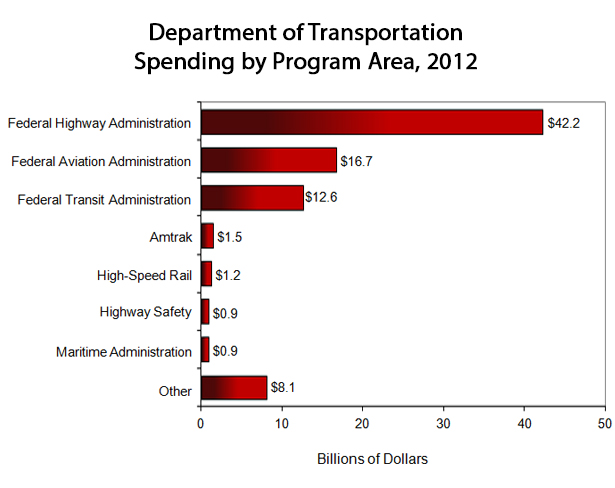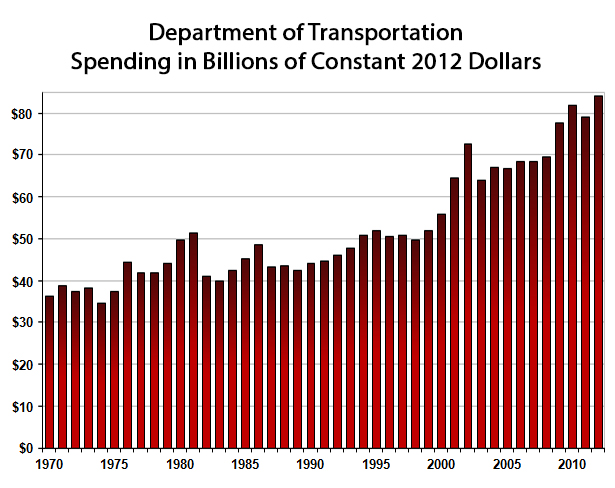THE NEED FOR A U.S. HIGH SPEED RAILROAD STRATEGY


U.S Funding For Railroads Versus Funding For Other Industries
The priorities of the United States federal government have long been proven to be consistently imbalanced, especially when it comes to the matter of transportation funding. It has been an unchanging constant that air and highway travel devour most of the funds allocated to this department.
Rail Funding:
Even in the early days of transportation development, America had already accumulated its share of traffic and congestion problems for travelers. Naturally, employees of the railroad industry, shippers, and government officials alike realized the growing need for the congestion problems to be taken care of. However, federal law at the time completely sternly restricted most railroad companies from responding to and keeping up with market conditions, stopping railroads from fortifying their operations. This shortcoming on behalf of the government left the railroad industry for dead compared to its air and highway counterparts, which had no major issues receiving proper funding. Had railroad been given the permission to pool their equipment or facilities, it is possible that the issues of traffic and crowding could have been somewhat eased. Unfortunately, the Interstate Commerce Act strictly prohibited railroads from pooling any equipment with other railroads, even if both parties agreed to do so with no reserve. The struggling railroad industry finally appealed to the ICC in 1917, requesting a simple 15% rate increase in order to help combat the piling debt that was growing steadily with wartime hustle and bustle. The request was rejected.
After the initial request to heighten revenue was ignored, the railroads continued to drown in a sea of debt and misdirection. In the same year, however, President Wilson decided to nationalize the railroad industry as a whole, which left the entire network of American railways in the hands of the United States Railroad Administration. Though the practice was once condemned by the government, railroads were finally given the green light to pool their materials and facilities, and soon ended up boosting the rates of the railway system by a boastful 28%.
Why has the railroad ultimately remained the neglected stepchild of the American transportation business? Technologically, our neglect for the railroad industry has left our country on the bottom of the totem pole as far as global development in transportation. In a time when much reform is taking place (or needs to be initiated), there is no better time than to embrace the addition of the high-speed rail system into our country. Not only would it revive a slowly dying mode of transportation, but it would also nurture several other dwindling factors of a graying American society.
Highway Funding:
America lives with a deadly reliance on automobiles. Though often a reliable source of travel, the dangers and downsides associated with highway travel far outweigh the good - yet it is still evident that much government attention is dedicated to the upkeep of these crumbling roadways and equally crumbling legislature regarding them.
-
The current budget for the USDOT reflects that 56% of the entire budget is reserved for highway funding alone. That percentage amounts to a steep $27,250,252,116. At the same time, a mere 22% is being used to fund railroad expenditures, amounting to $10,817,477,573. US Department of Transportation
-
This year, President Obama has been reported to have proposed DOUBLING the amount of funding for U.S. highway, transit and bridge projects. The extra funding would be borrowed from funds previously used to fund the military. Bloomberg News
-
Over the last 20 years, the nation's financial investment in its highway system has doubled. In fact, state and local investment far exceeded the monetary input of the federal government. Some time ago in 2002, it was confirmed that 54 percent of the Nation's capital investment in highways was provided by states and localities, while the remaining 46 percent was funded by the federal branch. U.S. Government Accountability Office
-
From 2009-2011, The Federal Highway Administration funding was estimated to be $500.9 million, as opposed to $2.3 million allocated to rail funding. North Dakota Legislative Branch
-
$3.7 billion has already been given to Federal-Aid Highways this year. U.S. Government Spending
Aviation Funding:
The airline industry has been much privileged in terms of financial support from the government. In order to keep up with the squandering of government funds used for the airline industry, airlines in the 1970s began charging airline passengers with a user fee. Several years after the introduction of the service fees, in 1988, the Congressional Budget Office discovered that regardless of the sum of the user fees already paid into the Airport and Airways Trust Fund, American taxpayers were still left to hand over $3 billion in subsidies per year to the FAA to uphold the consistent operation of airlines and all of their expenditures, including the pay of countless employees and technicians. The neglect of funding promised towards the railroad industry is not a national secret. It has been blatant since the early 1900s that Amtrak has been overlooked financially in favor of the air and highway modes of transportation.
-
In 2002, the amount of the federal transportation budget allotted to air travel amounted to $14 billion, or 23% of the budget as a whole. On the other hand, Amtrak was only handed $521 million. Amtrak also, in the 2000s, averaged annual losses that exceeded $1 billion. Missouri-Kansas Rail Coalition
-
The Airport and Airway Trust Fund currently raises upwards of $12 billion per year, resulting from a 7.5% tax on domestic airline tickets, a tax on each length flown, additional taxes on necessary gasoline and jet fuel, international flight taxes, as well as a few other fees. Amtrak, on the other hand, had a revenue of $2.7 billion in 2011. CATO Institute
-
The budget of the FAA in 2012 was a staggering $12.5 billion. Amtrak, however, had a subsidy of $1.6 billion.

Does The U.S. Need High Speed Rail?
The short answer to this question is a solid "yes." There is little room for doubt in the fact that a country-wide transition to a high speed rail system would be beneficial across the board. It is time for us to follow the footsteps of a promising trend that has already been adopted by other countries, such as China and France. Besides easing the tension of millions upon millions of travelers, the bullet-fast system would also be a breath of fresh air for the natural world. High-speed rail systems have the capability to relieve many negative issues of the current rail system, all the while operating on a diet of clean energy sources, including wind and solar energies. The introduction of these clean, electric trains would not only relieve a large portion of congestion and traffic epidemics, but would also relieve us of our constant dependence of natural resources such as oil. As rail usage grows more and more common, we could see a dramatic decrease in our emissions nationwide, certainly slowing the effects of global warming. Benefits of a widespread merge to the high-speed railways extend to each of the most critical areas of our current society. The machines are not just better for the environment, but they are also beneficial to our health; cleaner fuel leaves us with cleaner air. In addition, the high-speed rail system would do absolute wonders for the job market in this country. The establishment of these new-age rail systems, which already run smoothly in about 24 other countries, would bring millions of job opportunities to Americans.
Current High Speed Rail Systems in America
Railroad Transportation Abroad
The high speed rail system is no strange concept outside of this country, as countries such as Japan, France, Italy have already capitalized the new system. Japan was the first country to embrace high speed rails as a solution to civilian congestion. They first established a system of high speed rails in Tokyo, in 1964. The line, called the Shinkansen ("bullet train"), connected the two most flourishing cities in Japan, Tokyo and Osaka, with ease. The current network, much improved since its inception, has branched into several subdivisions that cover more ground and carry more people. The high speed rail from Tokyo to Osaka rotates close to 13 trains per hour, each train composed of 16 cars. In total, that's 1,323 passengers being transported at once. France did not fall too far behind in following the advancements in transportation showcased by Japan. France first established its high speed rail system, called the Train à Grande Vitesse (high-speed train) in 1970, Just six years after Japan. In an article from Trains Magazine, the TGV system, as it is referred to in short, was referenced as "the train that saved French railways." The French high speed rail system holds a number of records for speed and efficiency, earning a title in 2007 as the world's fastest conventional scheduled train. In Italy, the first high speed rail line was brought into fruition in 1977, and was a line that connected Rome and Florence - a trip usually lasting a scant 90 minutes. There are currently two main lines of high speed rail in operation. One is maintained by Trenitalia, a company who is the primary train operator for Italy as a whole. The flourishing nature of the faster rails in Italy have spawned the building of additional lines, which are now functioning and able to transport passengers to even more prime locations, such as Milan.
In summary, The great crossover to the high-speed rail system would help ease the strain of decades of governmental neglect that the rail industry has been dredged with relentlessly. However, progress is on a slow-moving train. As expected with any global-scale issue, there is a divide in opinion. Not all Americans are supportive of the transition to the faster electric rails, many news outlets and journalists deeming it as unable to function properly in the United States. President Obama and Vice President Joe Biden are both very much supportive of the idea of bring America up to speed with the high speed rail system. Though the Obama administration met some resistance in progress when the project was crippled by budget cuts in 2011, the transportation budget for this year is actually looking to be quite generous toward the high speed rail commitment. Obama has proposed that $50 billion will before infrastructure projects, including the building of high speed railways.
RELEVANT LINKS
US HIGH SPEED RAIL ASSOCIATION